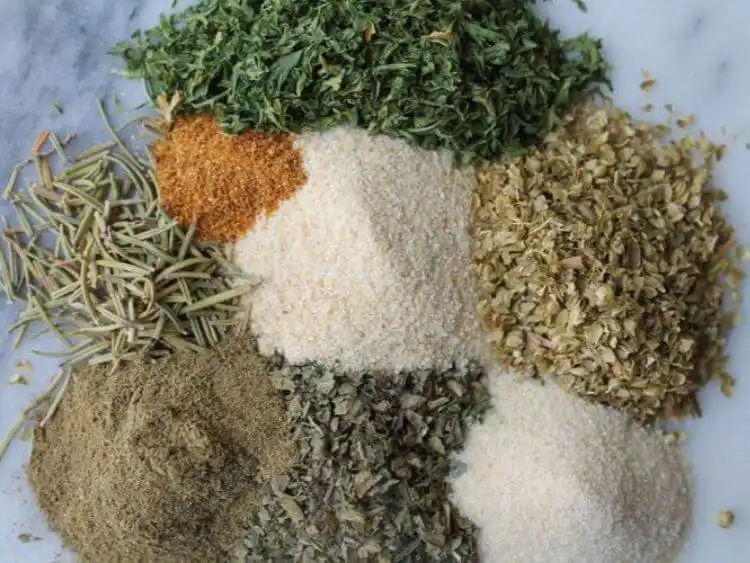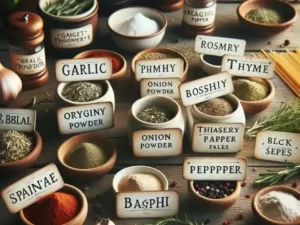Spaghetti seasoning, often an unsung hero in the culinary world, is a blend of spices and herbs that elevates the humble pasta dish to a new level of flavor. This seasoning is not just a mere addition; it’s a transformative ingredient that can turn a simple meal into a memorable dining experience.
The essence of spaghetti seasoning lies in its versatility. It typically includes a harmonious mix of garlic powder, onion powder, oregano, basil, rosemary, thyme, black pepper, and occasionally, red pepper flakes and fennel seeds. Each of these ingredients contributes its unique flavor profile, creating a symphony of tastes that complements the natural, earthy flavor of pasta. Garlic and onion powders lay a robust foundation with their pungent and slightly sweet tones. Oregano and basil, staples in Italian cuisine, add a warm, aromatic quality, reminiscent of Mediterranean summers. Rosemary and thyme introduce a slightly floral and peppery note, while black pepper adds a subtle heat that awakens the palate. For those who enjoy a bit of spice, red pepper flakes can be a zesty addition. Fennel seeds, though optional, offer a hint of licorice-like sweetness, rounding out the overall flavor.
Essential Ingredients for Spaghetti Seasoning
- Garlic Powder: A staple in spaghetti seasoning, garlic powder offers a robust, slightly sweet, and earthy flavor. It’s a concentrated form of garlic, providing a consistent and potent taste that forms the backbone of many Italian dishes.
- Onion Powder: Complementing garlic powder, onion powder adds a subtle sweetness and depth. It enhances the overall savoriness of the seasoning, making it a crucial component in achieving the right balance of flavors.
- Oregano: This classic Italian herb brings a slightly bitter, earthy flavor with hints of mint. Oregano is essential in imparting the traditional Italian taste that is synonymous with spaghetti seasoning.
- Basil: Sweet and fragrant, basil adds a fresh, slightly peppery flavor. It’s a quintessential herb in Italian cuisine, and its inclusion in spaghetti seasoning helps to create a more authentic and complex flavor profile.
- Rosemary: Known for its strong aroma and a flavor that is both lemony and pine-like, rosemary adds a distinctive Mediterranean character to the seasoning.
- Thyme: With its subtle, dry aroma and a slightly minty flavor, thyme complements other herbs while adding its unique touch. It’s a versatile herb that blends well with the other components of spaghetti seasoning.
- Black Pepper: A dash of black pepper introduces a mild heat and a pungent, woody aroma. It’s essential for adding a bit of spice and enhancing the overall flavor of the seasoning.
- Red Pepper Flakes: For those who prefer a spicy kick, red pepper flakes are a great addition. They bring a sharp, piquant heat that can be adjusted according to taste.
- Fennel Seeds: Optional but recommended, fennel seeds offer a sweet, anise-like flavor. They add a unique twist to the seasoning, giving it a slightly sweet and aromatic quality.
Step-by-Step Instructions to Make Spaghetti Seasoning
- Gather Your Ingredients: Start by assembling all the necessary herbs and spices. You will need garlic powder, onion powder, dried oregano, dried basil, dried rosemary, dried thyme, black pepper, optional red pepper flakes, and optional fennel seeds.
- Measure the Spices: For a balanced seasoning, use the following measurements: 1 tablespoon each of garlic powder and onion powder, 2 tablespoons of oregano, 3 tablespoons of basil, 1 tablespoon of rosemary, 1 teaspoon of thyme, 2 teaspoons of black pepper, red pepper flakes to taste, and a pinch of fennel seeds if desired.
- Mix the Ingredients: In a small bowl, combine all the measured spices. Use a whisk or a spoon to mix them thoroughly, ensuring that the ingredients are evenly distributed.
- Crush Larger Spices: If you have larger pieces of rosemary or fennel seeds, use a spice grinder or a mortar and pestle to lightly crush them. This helps to release their flavors and ensures a more consistent texture in your seasoning.
- Store Properly: Transfer the mixed seasoning to an airtight container. Store it in a cool, dry place like a pantry or a cupboard. This will help maintain its potency and freshness.
- Shake Before Use: Before using your homemade spaghetti seasoning, give the container a good shake. This helps to redistribute the spices and herbs, ensuring a uniform flavor in every use.
Related: French Onion Pasta Recipe
Variations and Substitutes
- Herb Substitutions: If you’re out of a specific herb, there are alternatives. For basil, try marjoram or thyme. If you lack oregano, marjoram or thyme can also suffice. Rosemary can be replaced with a bit of sage or thyme.
- Garlic and Onion Powder Alternatives: For those who can’t consume garlic or onion, asafoetida powder is a great substitute, offering a similar umami quality. Start with a smaller amount, as it has a strong flavor.
- Adjusting Heat Levels: Red pepper flakes add a spicy kick, but they can be omitted for a milder seasoning. Alternatively, increase the amount for extra heat, or substitute with a pinch of cayenne pepper.
- Salt-Free Version: Many commercial blends include salt, but you can easily make a salt-free version at home. This is especially useful for those on a low-sodium diet. Simply skip adding salt, and season your dishes separately as needed.
- Sweetness Adjustment: If you prefer a slightly sweeter seasoning, consider adding a pinch of sugar or a small amount of sweet paprika. This can balance the flavors, especially if you’re using more of the bitter herbs.
- Lemon Zest for Freshness: Adding a bit of lemon zest can bring a fresh, citrusy note to the seasoning. This works particularly well in summer dishes or with seafood pastas.
- Using Fresh Herbs: If you have access to fresh herbs, you can make a fresh version of the seasoning. Just remember that fresh herbs are less concentrated, so you’ll need to use more. A general rule is to use three times the amount of fresh herbs compared to dried.
- Gluten-Free Considerations: Ensure all your ingredients are gluten-free if you’re catering to a gluten-sensitive audience. Some spice blends can contain gluten-based additives.
Using Spaghetti Seasoning in Different Dishes
- Classic Pasta Dishes: Naturally, spaghetti seasoning is perfect for pasta sauces. Whether you’re making a marinara, Bolognese, or a creamy Alfredo sauce, a sprinkle of this seasoning can add depth and richness. It’s also great for tossing with olive oil and cooked pasta for a simple yet flavorful dish.
- Homemade Pizza: Elevate your homemade pizza by adding spaghetti seasoning to the pizza sauce. You can also sprinkle it on top of the pizza before baking for an extra burst of flavor. It pairs well with a variety of toppings, from classic pepperoni to a veggie-loaded pizza.
- Soups and Stews: This seasoning can be a game-changer for soups and stews. Add it to minestrone, vegetable soup, or even a hearty beef stew for an Italian twist. The herbs and spices blend well with a variety of ingredients, enriching the overall flavor of the soup.
- Meat Marinades: Use spaghetti seasoning as a rub for meats like chicken, beef, or pork. The herbs and spices complement the natural flavors of the meat, making it ideal for grilling, roasting, or pan-frying.
- Vegetable Roasting: Sprinkle some seasoning over vegetables before roasting them in the oven. It works particularly well with Mediterranean vegetables like zucchini, bell peppers, and eggplant. The seasoning brings out the natural sweetness of the vegetables while adding a savory note.
- Bread Making: Incorporate spaghetti seasoning into your bread dough for an Italian-style bread. It can also be mixed with melted butter and garlic to make a delicious garlic bread spread.
- Salad Dressings: Create an Italian-inspired salad dressing by mixing spaghetti seasoning with olive oil, vinegar, and a bit of mustard. This dressing is perfect for green salads, pasta salads, or as a marinade for grilled vegetables.
- Snack Seasoning: Sprinkle it over popcorn or mixed nuts for a savory snack. The seasoning adds an Italian twist to these simple snacks, making them irresistible.
- Egg Dishes: Add a pinch of spaghetti seasoning to scrambled eggs, frittatas, or quiches for a touch of Italian flavor. It pairs well with cheese and vegetables commonly used in these dishes.
- Seafood: Enhance seafood dishes like grilled fish, shrimp scampi, or a seafood pasta with a sprinkle of this seasoning. The herbs complement the delicate flavors of seafood beautifully.
Nutritional Information
Understanding the nutritional profile of spaghetti seasoning is crucial for those mindful of their dietary intake. This blend of herbs and spices offers more than just flavor; it brings various health benefits while being low in calories.
A typical serving of spaghetti seasoning, which is about one teaspoon, contains negligible calories, making it an excellent choice for flavoring dishes without adding extra calories. This aspect is particularly beneficial for those on calorie-restricted diets.
The seasoning is virtually fat-free, with no significant amounts of saturated or trans fats. This makes it a heart-healthy addition to meals, suitable for those managing cholesterol levels. Additionally, it contains no cholesterol, further supporting heart health.
Spaghetti seasoning is also low in carbohydrates, with most of its minimal carb content coming from dietary fiber. This fiber aids in digestion and can contribute to a feeling of fullness, which is helpful for weight management.
The herbs and spices in the blend are rich in various vitamins and minerals. Ingredients like garlic and onion powders are known for their antioxidant properties, while herbs like oregano and basil offer vitamins A and K, along with calcium and iron. These nutrients support overall health, including bone health and immune function.
It’s important to note that while the seasoning itself is low in sodium, it can be used in dishes that contain salt. Therefore, it’s advisable to monitor the overall sodium content of meals, especially for those on a sodium-restricted diet.
FAQs
Q1: What are the key ingredients in a traditional spaghetti seasoning? A1: Traditional spaghetti seasoning typically includes garlic powder, onion powder, oregano, basil, rosemary, thyme, black pepper, and occasionally red pepper flakes and fennel seeds. Each ingredient contributes to the overall flavor profile, creating a harmonious blend perfect for Italian dishes.
Q2: Can I make spaghetti seasoning without salt for a low-sodium diet? A2: Absolutely! You can easily create a salt-free version of spaghetti seasoning. Simply omit salt from the recipe, and you’ll have a flavorful blend that’s suitable for low-sodium diets. Remember to season your dishes separately with salt if needed, depending on your dietary requirements.
Q3: How can I store homemade spaghetti seasoning to maintain its freshness? A3: To keep your homemade spaghetti seasoning fresh, store it in an airtight container in a cool, dry place like a pantry or cupboard. This helps preserve the potency and flavor of the herbs and spices. Also, ensure to shake the container before use to redistribute the spices evenly.


